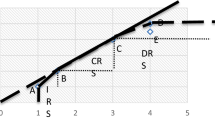Abstract
Data Envelopment Analysis (DEA) and Ratio Analysis (RA) are two widely used methods for measuring units’ productivity and any other criteria that could be assessed based on the available input and output variables. A number of researchers have studied DEA and RA and noted the positive and negative differences between them. Aggregated ratio analysis (ARA) model, which provide an important linkage between DEA and RA theory, is equivalent to the CCR DEA model, and this equivalence property offers a great deal of opportunities for DEA to be interpreted and applied in different ways. This paper extends the results of ARA model and proposes an extended aggregated ratio analysis (EARA) model, similar as the development from CCR model to BCC model in DEA context. The proposed model can offer an insight into the characteristic of returns to scale, playing the corresponding role as BCC model does. The numerical example is revisited in the paper and the results are compared.
Similar content being viewed by others
References
Ali, A.I., Lerme, C.S. & Seiford, L.M. (1995). Components of efficiency evaluation in data envelopment analysis. European Journal of Operational Research, 80(3): 462–473
Banker, R.D., Charnes, A. & Cooper, W.W. (1984). Some models for estimating technical and scale inefficiencies in data envelopment analysis. Management Science, 30(9): 1078–1092
Bowlin, W.F. (2004). Financial analysis of civil reserve air fleet participants using data envelopment analysis. European Journal of Operational Research, 154(3): 691–709
Charnes, A., Cooper, W.W & Rhodes, E. (1978). Measuring the efficiency of decision making units. European Journal of Operational Research, 2(6): 429–444
Chen, W.C & McGinnis, L.F. (2007). Reconciling ratio analysis and DEA as performance assessment tools. European Journal of Operational Research, 178(1): 277–291
Chen, Y & Ali, A.I. (2002). Output-input ratio analysis and DEA frontier. European Journal of Operational Research, 142(3): 476–479
Chen, Y., Li, K.W., Xu, H.Y & Liu, S.F. (2009). A DEA-TOPSIS method for multiple criteria decision analysis in emergency management. Journal of Systems Science and Systems Engineering, 18(4): 489–507
Cronje, J.J.L. (2002). Data Envelopment Analysis as a measure for technical efficiency measurement in banking — a research framework. Southern African Business Review, 6(2): 32–41
Despić, O., Despić, M & Paradi, J.C. (2007). DEA-R: ratio-based comparative efficiency model, its mathematical relation to DEA and its use in applications. Journal of Productivity Analysis, 28(1): 33–44
Emrouznejad, A & Amin, G.R. (2009). DEA models for ratio data: Convexity consideration. Applied Mathematical Modeling, 33(1): 486–498
Feroz, E.H., Kim, S & Raab, R.L. (2003). Financial statement analysis: a data envelopment analysis approach. Journal of the Operational Research Society, 54(1): 48–58
Gonzalez-Bravo, M.I. (2007). Prior-ratio-analysis procedure to improve data envelopment analysis for performance measurement. Journal of the Operational Research Society, 58(9): 1214–1222
Hollingsworth, B & Smith, P. (2003). Use of ratios in data envelopment analysis. Applied Economics Letters, 10(11): 733–735
Holló, D. & Nagy, M. (2006). Bank efficiency in the enlarged European Union. MNB working papers
Thanassoulis, E., Boussofiane, A & Dyson, R. (1996). A comparison of data envelopment analysis and ratio analysis as tools for performance assessment. Omega, International Journal of Management Science, 24(3): 229–244
Wu, D., Liang, L., Huang, Z.M & Li, S. (2005). Aggregated ratio analysis in DEA. International Journal of Information Technology and Decision Making, 4(3): 369–384
Author information
Authors and Affiliations
Corresponding author
Additional information
This work is financial support by National Natural Science Foundation of P.R.C. (70901069), Ministry of Education Foundation of Humanities and Social Sciences of P.R.C. (10YJC630208), Key Foundation of Natural Science for Colleges and Universities in Anhui, China (KJ2011A001) and Social Science Foundation of Anhui, China (AHSK07-08D25, AHSKF09-10D116, AHSK09-10D14).
Malin Song is an Associate Professor in School of Statistics and Applied Mathematics, Anhui University of Finance and Economics. He is a Standing Director of Institute of Industrial Economics, Anhui, China, and Research Fellow in Economic Development Research Center, Anhui University of Finance and Economics. His major field of study includes Environmental Economics and System Modeling and Analysis.
Jie Wu is a Lecturer in School of Management, University of Science & Technology of China. His major field of study includes Management Decision and System Modeling and Analysis.
Yumei Wang is a Professor in School of Statistics and Applied Mathematics, Anhui University of Finance and Economics. Her major field of study includes System Modeling and Analysis.
Rights and permissions
About this article
Cite this article
Song, M., Wu, J. & Wang, Y. An extended aggregated ratio analysis in DEA. J. Syst. Sci. Syst. Eng. 20, 249–256 (2011). https://doi.org/10.1007/s11518-011-5162-1
Published:
Issue Date:
DOI: https://doi.org/10.1007/s11518-011-5162-1




